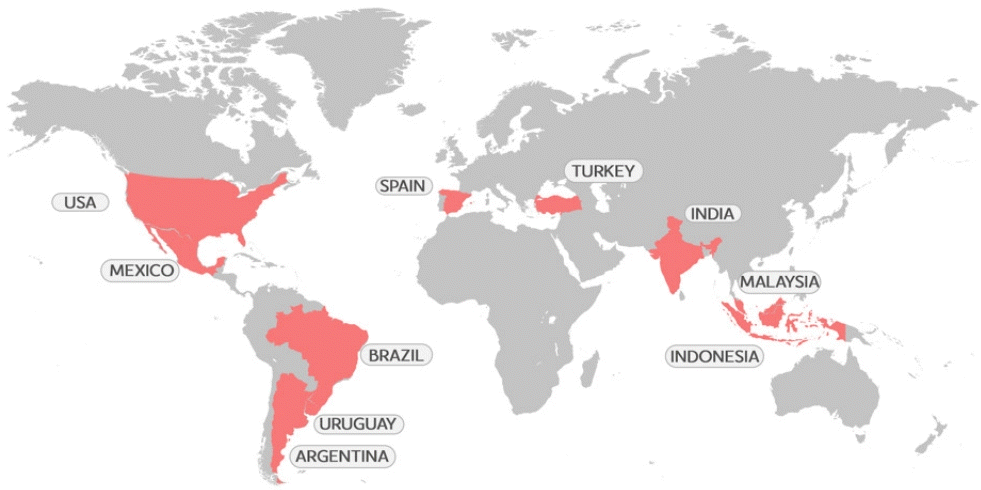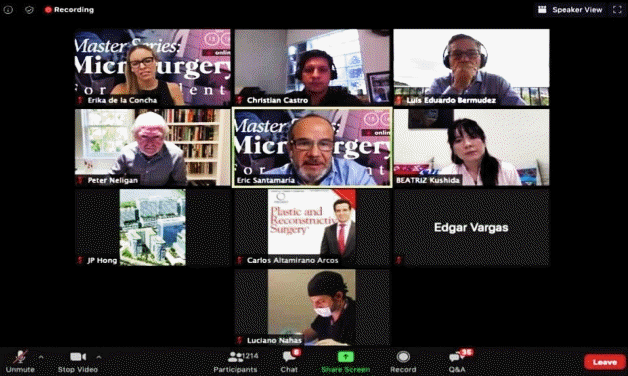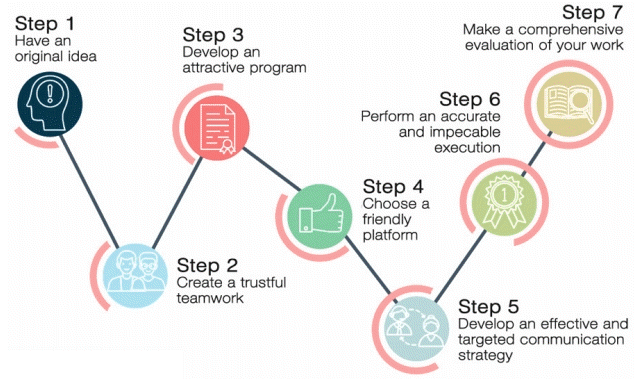Seven steps to deliver a low-cost, efficient, and high-impact online plastic surgery course during COVID-19 confinement: master series microsurgery for residents’ experience
Article information
Introduction
Plastic surgery education will never be the same after coronavirus disease (COVID-19) [1]. Social distancing and suppression of clinical and surgical training forced educational institutions to create or re-imagine new alternatives to continue their plastic surgery programs [2].
Online learning resources have emerged and been popularized during pandemic confinement [3]. Besides, many different formats have been delivered: private online sessions, Plastic Surgeons Virtual Ground Round Series, one or two-lecture webinars and clinical case discussions [4]. However, 2-day-long live courses are not easy to handle because of many difficulties: keeping the schedule with the live transmission, establishing a unique language, adjusting the time zone to make it international, keeping the audience motivated and interactive.
According to the need for high quality and free online tools, we decided to create the first 2-day online reconstructive microsurgery course named Master Series: Microsurgery for Residents (MSMR). It became a top-rated event reaching over three thousand users from 92 countries. The initiative was created by the Microsurgery Division of Plastic and Reconstructive Surgery Department at Manuel Gea Gonzalez Hospital in Mexico City.
Master Series: Microsurgery for Residents
After 4 weeks of preparation, the MSMR was held on the 15th and 16th of May, along with the COVID-19 pandemic. It was entirely developed and executed by three plastic surgery residents and coached by the senior author (Eric Santamaria). It comprised a 2-day course set in the Mexican GMT-5 time zone and broadcasted live through ZOOM Premium (San Jose, CA, USA). The platform was configured in the webinar mode and had the capacity for 3,000 simultaneous unique users connected. The official language was English. The advertising campaign was performed using a Facebook page and an Instagram profile where promotional videos, biographies and selffaculty invitations were posted. We found no need for an official webpage or hiring a professional-paid advertiser. No investment in Facebook Ads or paid promotion was made.
The academic program consisted of 31 lectures that were divided into two modules. Each of them was split into different sections: basic principles and workhorse free flaps harvesting for day 1, and microsurgical reconstruction according to anatomical regions for day 2. The faculty was composed of 29 worldwide renowned speakers from all across the world (Dr. JP Hong, Dr. Peter Neligan, Dr. Bohdan Pomahac, Dr. Scott Levine, senior author Dr. Eric Santamaria, among others).
Lectures were recorded several days before the event, using the ZOOM platform to adjust the talks to the previously published official schedule. Videos were then edited, adding interactive introductions to create smooth transitions and professional-looking performance.
After every section of lectures, live discussions were performed between two moderators (one senior moderator: reconstructive microsurgeon and one junior moderator: plastic and reconstructive surgery resident) and the respective faculty members. Back-up questions were previously arranged and others were read from the Q&A ZOOM’s tool. More than 350 questions were registered between days 1 and 2.
The total number of unique participants during the 2-day course was 3,317 from 92 countries and every continent (Fig. 1). The average number of simultaneous online users was 1,178 people, with a peak of 1,298 users for day 1 and 1,132 with a maximum of 1,286 for day 2. The transmission did not experiment any interruption, and it lasted 507 minutes on day 1 and 493 minutes on day 2 (Fig. 2).

Country of origin of the Master Series: Microsurgery for Residents (MSMR)’s attendees. Only the top 10 are lightened.
Official certificates of participation were given to all the users that reached at least 60% of attendance, according to the log-in database, and completed an after-course survey. The results of 1,111 completed questionnaires showed that 55.8% of the interviewees were residents. The impact was assessed with the following results: 93.9% of attendees would pursue a microsurgery career while 98.9% showed an increased interest after watching the course. The overall score (from 0 to 10 scale) of the MSMR was 9.06 ± 0.9.
While some researchers have published the role of teamwork and their experience in establishing an effective course, to the best of our knowledge, none of them has yet examined the implementation of reproducible steps to deliver a successful online course [5,6].
This study aims to summarize our model of an effective microsurgery online webinar and present a seven-step reproducible approach that could be used to deliver a successful, low-cost, and effective online course. We have shared our reflections to help illustrate the effectiveness of various strategies implemented by our team.
Seven-step pathway
The following sequence will help plastic surgeons build a successful online course. It is mainly based on the authors’ experience managing online webinars empathizing the popularity gained after the MSMR (Fig. 3).
Step 1. Have an original idea
Being creative is the first condition to deliver a successful online course. The term innovation is described as introducing something new, including a concept, process, or mechanism [7]. Innovation is key in plastic surgery since it has been acknowledged as a specialty for evolutionary procedures and products [7]. Most innovations are the result of a conscious and purposeful search for opportunities producing breakthrough ideas [8].
The first step towards developing a successful online course is to implement an innovative and original idea that should focus on the educational needs of the plastic surgery society. An attractive title is key. A careful analysis of the situation is required, and some circumstances must be considered:
(1) Special known situations: COVID-19 pandemic or any other worldwide condition affecting surgical activities, new striking discoveries, mass global controversies.
(2) Potential target groups: plastic surgeons working in developing countries, specific societies, residents, fellows, even medical students.
(3) A precise date choice: consider your primary population target group and set the date by time zone according to that choice. If a webinar is best conducted during the week or the weekend, it has not yet been established.
(4) HOT topics: social media trending topics, survey results and every online information can be used to determine which subjects may be the most interesting for the audience.
Step 2. Create a trustful teamwork
Teamwork is a process that describes interactions among team members who combine collective resources to resolve task demands [9].
Developing a diverse organization team consisting of members with compatible skill sets is imperative to the team’s success. The members and roles of the team must be carefully considered and selected to fill necessary skill gaps. The importance of a mentoring leadership relies on the fact that a most experienced team member should guide the whole group and take crucial decisions, even in times of uncertainty [10].
Team members should know how to cope with failures, be flexible in changing directions, and maintain a positive attitude [11]. Teamwork allows people to experience sophisticated and large-scale projects which cannot be completed individually [12].
Functions of the team are:
(1) Set specific goals.
(2) Work collaboratively.
(3) Share responsibilities: create a group of moderators
(4) Make collective decisions.
(5) Evaluate the whole experience despite the result.
(6) Accept difficulties and adversity.
Step 3. Develop an attractive program
To catch a big audience, maintain high levels of connectivity and high-rate feedback, an attractive program must be delivered. The attractiveness of the course is based on the optimization of content and design.
(1) Content: consider creating a faculty crew composed of renowned and fluent speakers, preferably experts of specific areas. Topics must be distributed according to an underlying intention: from simple to complex, from general to specific, from basic to advanced. A state-of-the-art structure must be followed. Consider recording the lectures in advance, to allow video editing avoiding incidentals.
(2) Design: a professional-looking course layout is crucial to keep users engaged. An expert designer is not a formal requirement. Nowadays, friendly applications for image and video editing exist, encouraging the team to create high-quality audiovisual content (e.g., Wondershare Filmora, iMovie, Canvas, OBS studio).
Regarding the design, we recommend the following considerations:
(1) Attractive artwork: create a logo that represents your webinar. Use an appealing font style and broaden your mind when considering the name of the course.
(2) Colors: maintain a constant color base for your social media posts, logo and font styles. Use basic color theory and avoid common mistakes when choosing your colors like using light fonts over a pale background.
(3) Photo and video quality: low-quality pictures are often seen and remain unnoticed. Always use high-quality pictures. Avoid overlapping and basic photographic edition mistakes like cropped or pixelated edges. They suggest a rudimentary appearance rather than the desired professional look. We recommend a minimum resolution of 1,080 × 720 pixels.
(4) Verify your grammar.
(5) Video transitions: a 5-second introductory video can be added to the beginning of a lecture. It produces a delightful moment and takes off the monotony.
(6) Promotional videos: if needed, they can be placed during the pauses between live streaming. You can use looped promotional videos regarding sponsors or non-paid advertisers (e.g., further webinars and upcoming congresses).
(7) Music and sound: they are a complement to the overall design strategy. Free sources of non-copyrighted audios can be found on the internet.
Step 4. Choose a friendly platform
The best platform choice is the one that you feel more familiar within a short period. It is mandatory to make tests and simulations to discover every tool and feature that can be modified according to the meeting’s requirements.
As it has been already used for plastic surgery education, we consider ZOOM as an excellent choice for online learning [13].
ZOOM webinars let you easily host significant online events with video, audio, and screen sharing with up to 100 video participants and 10,000 attendees. Features in this mode are tailored for large audiences with registering features, full host controls, polls, questions and answers, attendees raise hand option, chat and record function.
We recommend the following basic/advanced settings to optimize ZOOM’s platform:
(1) Choose webinar mode.
(2) Send the registration form with adequate demographic questions (e.g., age, country of origin, educational status).
(3) Disable annotations.
(4) Disable microphones and cameras for all the attendees.
(5) Disable screen sharing for all the participants.
(6) Apply an adequate role for each member (panelists and moderators).
Step 5. Deliver and effective and targeted communication strategy
Social media advertising campaigns are feasible. However, a new communication scheme with visual impact and targeted grouping can be introduced to save the budget. Among the many social media platforms the world has to offer, the two that reign supreme are Facebook and Instagram [14].
Facebook allows for multiple pictures per post, videos over an hour-long, and detailed text descriptions. On the other hand, Instagram allows photos with a small amount of descriptive text, short video segments of 59 seconds or less. Hashtag indexing of posts tends to be more important on Instagram, as many users search for and follow not just individual accounts, but new posts on hashtag subjects of interest [15].
For these reasons, educational or explanatory posts may be fit more naturally on Facebook than other current platforms. Regarding the demographic distribution, Facebook tends to encompass adults, while Instagram is oriented to younger users [15].
E-mails have lost value due to increasing Spam filtering, but some software like Mailchimp can create massive new sharing or keep everyone updated. ZOOM also provides an e-mail alert feature that can be useful when the start date of the course is closed.
Recommendations:
(1) To promote the course, use animated videos.
(2) Share updated Bios of the faculty.
(3) Self-introducing videos.
(4) Interactive posts: use open questions to increment the number of interactions.
(5) Use Facebook related-private groups to share invitations.
(6) Use WhatsApp/Telegram related groups to share invitations.
(7) Follow Instagram users who have similar accounts and interests.
(8) Use common and popular hashtags.
(9) One official Facebook and Instagram account are enough. Do not divide the potential audience.
Step 6: Perform an accurate and impeccable execution
The first measure to guarantee a successful performance is to prevent any threats that may disrupt the course:
(1) Difficulties during faculty signing-in.
(2) Stable and powerful internet connection availability.
(3) Potential failure of the master control computer and lack of back-up.
(4) Unexpected time delays.
(5) External sources of noise.
Test meetings are critical because they minimize errors that may occur during the event. Providing an efficient channel of communication (WhatsApp/Telegram) with the entire organizational team is crucial for exchanging valuable information at the time of the event and for the prevention and resolution of any possible issues. Webinars can be delivered virtually anywhere.
Documentation of the whole process is a determining factor for success. By documenting, you can ensure efficiency, consistency and feedback for the member’s team group. To optimize the execution the following steps are essential:
(1) Reliable computer (processor of at least 2.4 GHz, and more than 8 GB of RAM)
(2) Reasonable internet upload speed (at least 15 Mbps)
(3) Proper and fluid interaction with participants.
(4) Smooth transitions between recorded lectures and live discussions.
(5) Put your effort towards adjusting to the schedule at all time.
Step 7: Make a comprehensive evaluation of your work
Evaluating results is vital to recognizing performance, finding shortcomings, and moving towards quality improvement. Efficient and ineffective approaches may be assessed for progress. A pre- and postcourse evaluation or survey can be done to obtain viable feedback from the attendees and faculty members. This will be useful to improve the development of future events. However, the learning process is not directly observable and evaluating it is out of the goals and beyond the scope of a webinar.
Extra step: Be prepared for the unpredictable
Despite your efforts to be prepared and develop the best online course, you need to give space for the unexpected. Sometimes things that are beyond your control may occur and have devastating effects on your project. Electricity could shut down, Wi-Fi could stop running, hardware inconveniences. Be prepared and have a plan B. The person in charge of the platform needs the have knowledge and experience to use the software as intended, requiring to have spend additional time learning the software.
Limitations
Online courses may be appealing at first sight. However, compared to in-person events, some relevant statements must be remarked.
(1) Online systems like ZOOM cannot guarantee that attendees will not record the lectures with the use of cell phones or recording sources that do not belong to the current platform in use [2]
(2) Online events do not encourage industry to expose their products in a massive and depth detail as this would extend the course unnecessarily.
(3) The increase in the number of spectators may convert a cheap platform into a costly one.
(4) You cannot guarantee the same audio and video quality streaming because it gets adjusted to the spectator’s download speed.
(5) ZOOM has some limitations in certain countries [16].
(6) The impersonal nature of the virtual learning environment creates a propensity for detachment and disengagement. While the video function is turned off and the microphone is muted, a participant can completely disengage from virtual learning while still appearing to be present [17].
Conclusions
Following this seven-step pathway for making a successful online course is reliable and feasible, as was executed during the MSRM. It is a myth that a large number of people need to be involved in developing a high-quality course, besides it is preferable to create efficient teamwork with a proper task distribution. This guideline has proved to be an excellent replicable formula to continue developing online-based education strategies to compensate for the lack of in-person events during the COVID-19 pandemic or any possible similar future situation.
Notes
Conflict of interest
Eric Santamaria is an editorial board member of the journal but was not involved in the peer reviewer selection, evaluation, or decision process of this article. No other potential conflicts of interest relevant to this article were reported.
Author contribution
Conceptualization: E Santamaria, L Nahás-Combina, C Altamirano-Arcos, E Vargas-Flores. Methodology: L Nahás-Combina, C Altamirano-Arcos, E Vargas-Flores. Project administration, visualization: E Santamaria. Writing - original draft: E Santamaria, L Nahás-Combina, C Altamirano-Arcos, E Vargas-Flores. Writing - review & editing: L Nahás-Combina, C Altamirano-Arcos, E Vargas-Flores.


